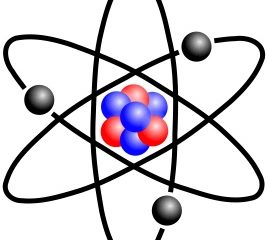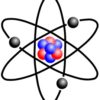Matter: Matter is anything that occupies space and has mass.
Example : Air, water, Table, Books etc.
Atom: Atom is the smallest particle of the matter that can not exist independently e.g O, N, Cl etc.
Molecule: Molecule is the smallest particle of the matter that can exist independently. e.g O2, N2, Cl2, etc. Thus, O cannot exist in nature but O2 exists.
PROPERTIES OF MATTER
- Matter is made up of small particles i.e:- Molecules
Description:- When we add water in a colourful water solution, its colour turns lighter. This is due to dissolving or spreading of the molecule equally throughout the solution. It is possible only in that condition when molecules are small in size.
(2) There is space between molecules of matter.
Description:- We can move our hands through air, water. It is due to presence of spaces between molecules that allow the objects to move through it. Solids also have spaces but very few. So we need a high energetic force to move our hands or objects through solids as Kungfu fighters do. They can break the bricks by striking these with their hands.
(3) Molecules are continuously moving in the matter.
Description:- If we dip a crystal of Kmno4 in water, then after some time the whole water turns violent in colour, instead of that of bottom. It is due to the movement of molecules through out the solution.
- There is a force of attraction between molecules of matter.
Description:- We need an energy to break any object by putting its two opposite ends in opposite directions. It is due the force of attraction between molecules that enables the object to oppose to be broken. The strength of force of attraction varies from one kind of matter to another.
STATES OF MATTER:-
There are three Physical states of matter.
1 Gas:- There is less attractive force along its particles and they have high kinetic energy. There is large distance among different molecules. The shape and volume of gas are indefinite. Ex. Air, Water Vapour.
2 Liquid:– Liquids have constant volume but indefinite shape. Ex. Water.
3 Solid:- There is a very small distance among different particles. They have definite shape and volume. Ex. Ice, Wood ,Stone.
INTERCHANGING OF STATES:-
SOLID TO LIQUID:- Process of changing of a solid into liquid is called melting. The temperature at which the process starts is called melting point of the solid. The energy needed for this process is in the form of heat. It increases the temperature of the solid due to which the molecules start moving rapidly as the heat energy is converted into kinetic energy. When the molecules of solid attain the energy equal to that of liquids, they start changing into liquid state. The shape between molecules also increased due to their movement and it also becomes equal to that of liquids.
Note:- During the whole melting process the temperature of the solid remains constant. During this time the heat energy which is given to the solid is used in changing the state of molecules/matter. As this heat is not measurable by thermometer, it is known as latent heat of fusion & melting.
LIQUID TO GAS :- When all the molecules of a solid are converted into liquid state, the heat energy which is being supplied continuously starts changing the temperature of the liquid. The molecules of it start moving more rapidly as they get more energy. When the molecules attain energy equal to that of gas, they undergo changing into gases state. The process is called vapourisation or Boiling and the temperature at which this process starts is called boiling point.
Note: During the whole process the temperature of the liquid remains the same. the heat energy is used to convert the state. As this energy can be measured by thermometer, it is called latent heat of vapourisation
SOLID TO GAS:- Some substances change directly into gas from their solid state. The substances in which this happen have their melting point and boiling point equal approximately. At a result when these substances melt they immediately start vapourising. So their liquid state remains absent. This process is called sublimation. Example: Campher, Nepthalene.
FACTORS AFFECTING CHANGE OF STATES:- Following two factors are responsible for changing or not changing of states:-
(a) Temprature:- The states change from solid to liquid and liquid to gas on increasing temperature.
(b) Pressure:- On increasing pressure gases change into liquids and so on.
![]() L.P.G is a gas but it is stored in cylinders in the form of liquid by compressing (increasing pressure on) it.
L.P.G is a gas but it is stored in cylinders in the form of liquid by compressing (increasing pressure on) it.
Evaporation: It is a process similar tom vaporization to some extent. The only difference is that vaporization take place when whole substance is heated, but in evaporation no need to heat whole substance (liquid). It takes part on the surface of liquid. Thus it is a surface phenomena, when molecules of the surface of any liquid get energy by any means they start leaving the surface by making it cooler.
Why Evaporation Gives Cooling Effect:- The molecules that leave the surface at the liquid take the energy from the surface in the form of heat (temperature). This energy makes them capable of leaving the surface. At this time there is a decreasing at temperature of the surface as its heat is transferred to the molecules that leave the surface. Thus this surface becomes cool.
For example:- When sweat is evaporated from our perspiring body, we feel cool at that time.
Factors Effecting Evaporation:-
(a) Temperature: – The rate of evaporation increases with increasing temperature.
Evidence: Clothes dry up more fastly in summers rather than in winters. Same as in day and night.
- Pressure: – Evaporation retards on increasing pressure
Evidence: – Evidence on hill areas is faster than that of land areas.
- Surface Area:- Rate of evaporation increases with increasing surface area.
Evidence:- An unfolded handkerchief can dry up more quickly than a folded. A glass of water will take too much time for drying up but this can easily be done by spreading it on the floor. (In this way the surface area for evaporation increases)
(d) Wind: – Rate of evaporation increases with increasing wind velocity.
Evidence: – Clothes can easily dry up in the wind rather than in that place where there is not wind.
(e) Humidity: – Evaporation retards on increasing humidity. Humidity in the presence of water vapours in the air. So the most of the energy is consumed by these vapours. The remaining water or any liquid remains unevaporated. More of it the atmosphere is already filled with water, so if does not have the capacity to absorb more water (in case of much humidity)



